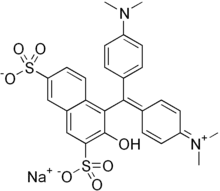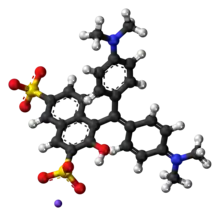 | |
 | |
| Names | |
|---|---|
| IUPAC name
Sodium 4-[(4-dimethylaminophenyl)-(4-dimethylazaniumylidene-1-cyclohexa-2,5-dienylidene)methyl]-3-hydroxynaphthalene-2,7-disulfonate | |
| Other names
Food green S; FD&C green 4; acid green 50; lissamine green B; wool green S; C.I. 44090; E142 | |
| Identifiers | |
3D model (JSmol) |
|
| ChemSpider | |
| ECHA InfoCard | 100.019.463 |
| E number | E142 (colours) |
PubChem CID |
|
| UNII | |
CompTox Dashboard (EPA) |
|
| |
| |
| Properties | |
| C27H25N2NaO7S2 | |
| Molar mass | 576.62 g/mol |
| Melting point | 210 °C (410 °F; 483 K) (decomposes)[1] |
| Hazards | |
| GHS labelling:[2] | |
 | |
| Warning | |
| H302, H315, H319, H335 | |
| P261, P305+P351+P338 | |
Except where otherwise noted, data are given for materials in their standard state (at 25 °C [77 °F], 100 kPa).
Infobox references | |
Green S is a green synthetic coal tar triarylmethane dye with the molecular formula C27H25N2O7S2Na.
As a food dye, it has E number E142. It can be used in mint sauce, desserts, gravy granules, sweets, ice creams, and tinned peas. Green S is prohibited as a food additive in Canada, United States, Japan, and Norway. It is approved for use as a food additive in the EU[3] and Australia and New Zealand.[4]
Green S is a vital dye, meaning it can be used to stain living cells. It is used in ophthalmology, along with fluorescein and rose bengal, to diagnose various disorders of the eye's surface, dry eyes for example.
References
- ↑ "Safety Data Sheet for Green S". Sigma-Aldrich.
- ↑ Sigma-Aldrich Co., Green B. Retrieved on 2019-06-09.
- ↑ UK Food Standards Agency: "Current EU approved additives and their E Numbers". Retrieved 2011-10-27.
- ↑ Australia New Zealand Food Standards Code"Standard 1.2.4 - Labelling of ingredients". Retrieved 2011-10-27.
External links
- Eighteenth Report of the Joint FAO/WHO Expert Committee on Food Additives (JECFA), Wld Hlth Org. techn. Rep. Ser., 1974, No. 557. FAO Nutrition Meetings Report Series, 1974, No. 54.
- http://www.efsa.europa.eu/en/efsajournal/pub/1851
- http://apps.who.int/food-additives-contaminants-jecfa-database/chemical.aspx?chemID=2119
- http://www.fao.org/food/food-safety-quality/scientific-advice/jecfa/jecfa-additives/detail/en/c/107/
This article is issued from Wikipedia. The text is licensed under Creative Commons - Attribution - Sharealike. Additional terms may apply for the media files.